LONDON’S ST. PAUL’S SURVIVES OVERNIGHT HIT
London, England · April 16, 1941
This night and early the next morning in 1941, when London’s historic St. Paul’s Cathedral was bombed and damaged, marked the start of the final phase of the Blitz (September 7, 1940, to May 21, 1941), which reached its climax on May 10 with a deadly raid that hit the House of Commons, Westminster Abbey, and the British Museum and left a third of London’s streets impassable, 1,400 civilians dead, and 1,800 injured.
Over a period of almost 37 weeks, the British capital was attacked 71 times. Other cities were also targeted, among them Birmingham, Liverpool, Coventry, Bristol, Glasgow, Manchester, Southampton, and Portsmouth. Upwards of 43,000 civilians were killed in the air campaign, and figures for the injured run as high as 139,000. For this Hermann Goering’s Luftwaffe paid in spades: 3,363 aircrew and 2,265 aircraft lost (summer 1940 to May 1941).
The Blitz did not pave the way for Operation Sea Lion, the planned German invasion of Britain, any more than did the earlier aerial Battle of Britain (July 10 to October 31, 1940). By May 1941 Adolf Hitler’s strategic priorities had shifted from bombing Britain to building up the Wehrmacht (German armed forces) for an invasion of the Soviet Union—Operation Barbarossa. As a result of the change, two thirds of the Luftwaffe was transferred to Eastern Europe.
Hitler’s air offensive over Britain had failed for any number of reasons. One was London’s sheer size: its nine million people—one-fifth Britain’s population—sprawled over 750 sq. miles. Another was the Luftwaffe’s poor intelligence about things British and its unfocused strategy: Bomb population centers? Bomb weapons factories? Bomb distribution networks and ports? Throw into this mix the incompetence and neglect that characterized the German air armaments industry, saddled with a fleet of load-limited medium bombers unable to deliver knockout blows—all this helps explain Britain’s ability to slog on until Japan’s fateful Pearl Harbor misstep.
It was the shock of December 7, 1941, that propelled the U.S. over the edge and into armed conflict with Germany’s Axis ally in the Asia Pacific area, Japan. And as of December 11, 1941, following Hitler’s reckless declaration of war on the United States, into armed conflict with Germany as well. Two years later the tide of global war was turning against both aggressor nations.
[amazon_carousel widget_type=”ASINList” width=”600″ height=”200″ title=”Recommended Reading” market_place=”US” shuffle_products=”False” show_border=”False” asin=”0752450158,0760339368,0151014043,1842737503,0679432981,0859791483,1400067588,030435676X,0947554823,0091910048″ /]
The Blitz, Germany’s Strategic Bombing of Great Britain, September 7, 1940, to May 21, 1941
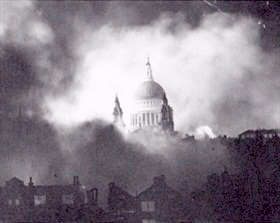 | 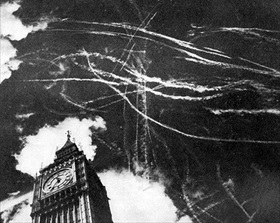 |
Left: London’s St Paul’s Cathedral, undamaged, ringed by clouds of smoke in this iconic photograph taken on December 29, 1940. The cathedral was struck four times during the Blitz: in September, October, and December 1940 and in April 1941.
![]()
Right: The London sky above Big Ben and the Houses of Parliament following a bombing and dogfight between British and German planes in 1940.
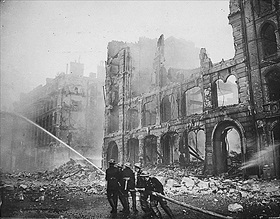 | 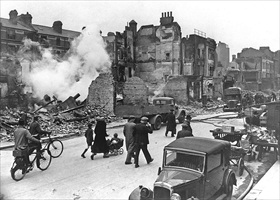 |
Left: Firefighters put out a blaze in London after an air raid during the Blitz in 1941. Less than halfway into the 37 weeks of the Blitz, the Luftwaffe had dropped more than 13,000 tons of high explosives and nearly 1,000,000 incendiaries on London.
![]()
Right: A street of ruined houses in London. More than one million London houses were destroyed or damaged and close to 20,000 killed during the 267 days of the Blitz. By contrast the Allied bombing raids on the large North German port and industrial center of Hamburg during the last week of July and the first week of August 1943 (Operation Gomorrah) delivered the single most terrible blow suffered by any European metropolis since the beginning of the war, killing 42,600 civilians, wounding 37,000, and razing three-quarters of Germany’s second-largest city.
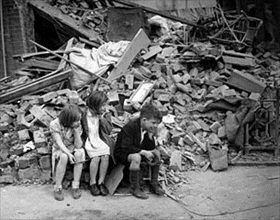 | 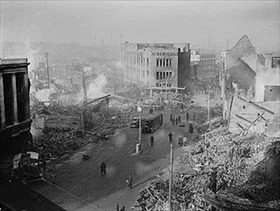 |
Left: Children of an eastern suburb of London made homeless by the Blitz. Though militarily ineffective, the Blitz caused enormous damage to Britain’s infrastructure and housing stock.
![]()
Right: Coventry city center after 449 German bombers had dropped 530 tons of bombs on the night of November 14/15, 1940, killing 554 people and seriously injuring 865, almost all of them civilians. It is said that the series of horrific Anglo-American raids on Hamburg in July–August 1943 did a great deal to lift morale in Britain, whose citizenry had seen Coventry, London, and many other English urban centers attacked and bombed with the heavy casualties and much destruction.
Amateur Color Film of Destruction Caused by London Blitz, 1941 (Suggest silencing the sound of the projector)
![]()

 History buffs, there is good news! The Daily Chronicles of World War II is now available as an ebook for $4.99 on Amazon.com. Containing a year’s worth of dated entries from this website, the ebook brings the story of this tumultuous era to life in a compelling, authoritative, and succinct manner. Featuring inventive navigation aids, the ebook enables readers to instantly move forward or backward by month and date to different dated entries. Simple and elegant! Click
History buffs, there is good news! The Daily Chronicles of World War II is now available as an ebook for $4.99 on Amazon.com. Containing a year’s worth of dated entries from this website, the ebook brings the story of this tumultuous era to life in a compelling, authoritative, and succinct manner. Featuring inventive navigation aids, the ebook enables readers to instantly move forward or backward by month and date to different dated entries. Simple and elegant! Click 











